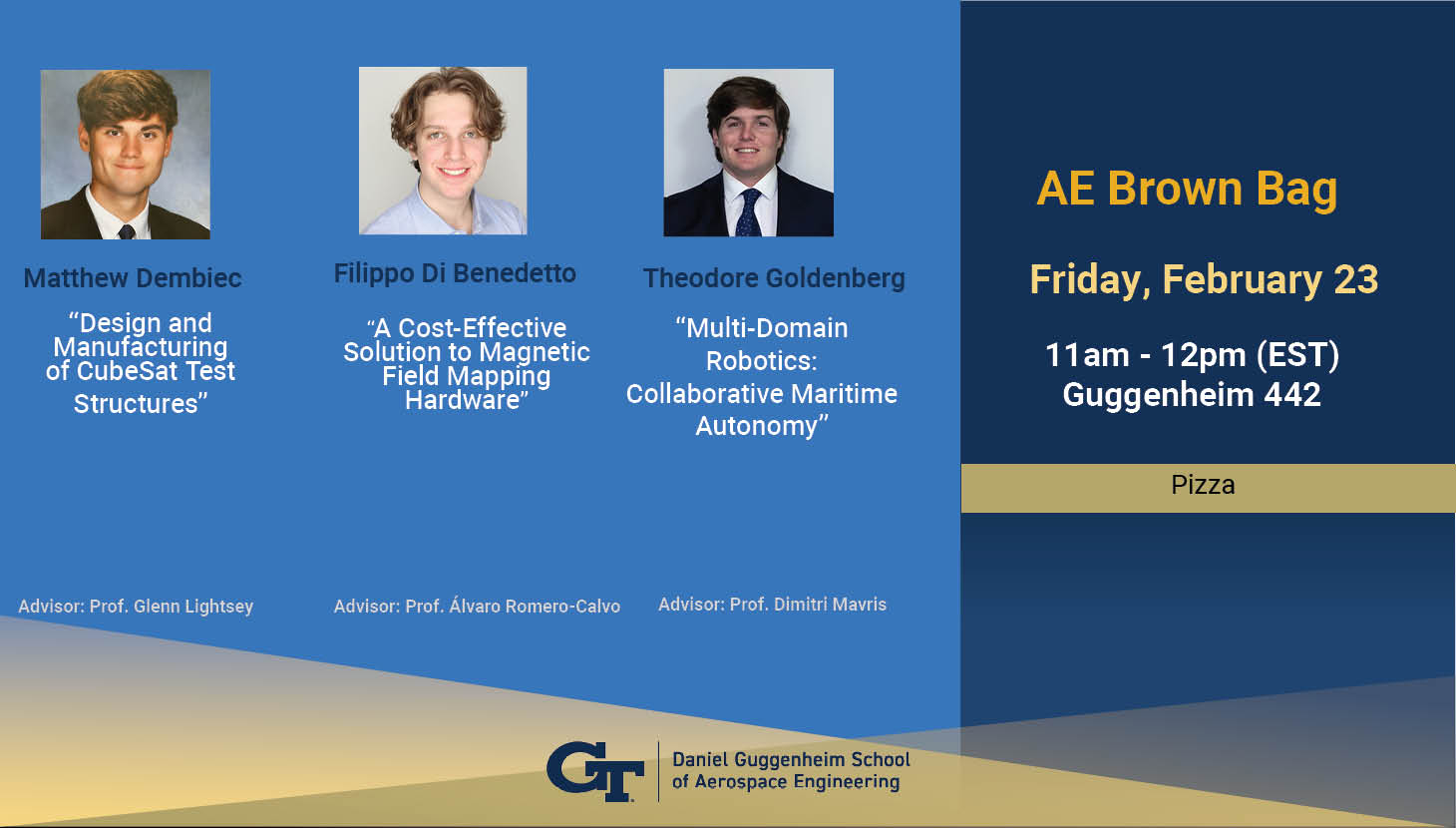
AE Brown Bag Seminar
Friday, February 23
11:00 a.m. -12:00 p.m.
Guggenheim 442
Pizza Served
Matthew Dembiec
Title:
Design and Manufacturing of CubeSat Test Structures
Abstract:
To test hardware utilized for various CubeSat propulsion systems under development in SSDL, machined structures are necessary. Because of the nature of the systems being tested, it is most efficient to design the test equipment from scratch using SolidWorks, covering everything from general geometry to integration and placement of specific fasteners. The structures can then be manufactured in machine shops or maker spaces on campus at Georgia Tech. Multiple problems in design and manufacturing were solved, including selection of proper fasteners, placement of components, usage across multiple systems, and machining tolerances. As a result, test structures were developed to be used in both current and future projects within the propulsion team.
Faculty advisor:
Professor Glenn Lightsey
Filippo Di Benedetto
Title:
A Cost-Effective Solution to Magnetic Field Mapping Hardware
Abstract:
Novel applications of magnetism drive many cutting-edge research experiments performed in groundbreaking research laboratories around the globe. Due to the inherent material variations in hysteresis-producing coils, imperfections in the magnets made will be produced. Thus, an obstacle to working with magnetic materials can be the machines used to precisely measure the magnetic fields to document such imperfections. Due to how specific and precise the commercial measuring equipment are, it is common for such equipment to have a price tag of more than five figures, which depending on the size and budget of the research group, can pose a significant monetary obstacle to magnetism related research.
The goal of this project is to create a cost-effective solution to this problem. The primary method of achieving the goal set out is to analyze the workings of a magnetic field mapper that is low cost and can achieve the resolution and precision that would be sufficient for research purposes. The motivation for this project came from the frequent use of magnetic tools in aerospace engineering applications, and the common issue of price with regards to magnetic field research. These mappers, for example, allow for larger-scale experiments in research in liquid phase separation in microgravity, especially such as constructing a Halbach array [1,2]. The team’s goal was to assemble such an device with a cost less than five thousand dollars.
This project demonstrates that many unrelated types of hardware and software can be coupled together to create an integrated system with greater capabilities. The project consists of mounting a cost effective sensor, a Magvector MV2, onto the head of a 3D printer, an Ender 3, and using software to read the sensor, move the head, and graph the results. This allowed the creation of a fully functional magnetic mapping platform that is capable of measuring magnetic field vectors up to 30 Tesla with a magnetic resolution of 0.05 mT and a spatial resolution of 0.1mm, which allows the mapping of N52 magnets up to 2.54 cm cubes.
Faculty Advisor:
Professor Álvaro Romero-Calvo
Theodore Goldenberg
Title:
Multi-Domain Robotics: Collaborative Maritime Autonomy
Abstract:
Autonomous systems aim to revolutionize the performance in many industries. Specifically, the Office of Naval Research (ONR) has a unique interest in the design of maritime collaboratively autonomous systems in the maritime environment. Ongoing design research aims to enable new use cases, improve designs, and reduce costs. These maritime systems can involve surface, sub-surface, aerial, and even space systems. This research aims to characterize system performance related input sensor parameters. These results will then be used to create tools to more accurately determine performance of autonomous systems in the early design stages of these systems.
Faculty advisor:
Professor Dimitri Mavris